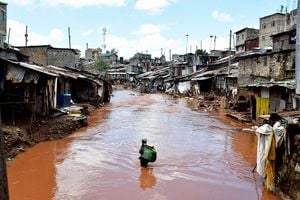Seven out of 10 children can’t concentrate in class due to hunger and malnutrition

A child is screened for malnutrition at Kanamkuny village,Turkana County on October 11, 2022.
What you need to know:
- According to Africa Pulse Report 2024, the endless pangs of hunger have made 90 per cent of 10-year-olds in Sub-Saharan Africa unable to read simple text.
A new World Bank report has found that seven in 10 children in Sub-Saharan Africa, including Kenya, are not benefiting from pre-primary education because they are hungry and malnourished.
According to Africa Pulse Report 2024, the endless pangs of hunger have made 90 per cent of 10-year-olds in Sub-Saharan Africa unable to read simple text.
World Bank researchers say the food crisis is largely brought about by extreme weather events that have buffeted swaths of the African continent in recent years and are expected to continue as global climate change worsens.
“The worst floods in decades in central and western Africa, multi-year droughts and floods in Eastern Africa, and the rising impact of cyclones in Southern Africa continue to weigh on economic activity,” the World Bank noted while explaining that climate change amplifies the impacts of conflict and global shocks on agricultural yields, food production, and trade, thus raising food security problems in Sub-Saharan Africa and the rest of the continent.
This is why last year, more than one in five people faced hunger in Sub-Saharan Africa, and more than 70 per cent of the population was unable to afford a healthy diet.
According to the integrated phase classification for acute malnutrition (IPC AMN) report by the Kenyan government in February 2022, the nutrition situation in the country had deteriorated within the same phase in most counties compared to the August 2021 analysis.
The data then showed that the number of children requiring treatment for acute malnutrition had risen by 15.6 per cent from 652,960 cases reported in August 2021.
“The nutrition situation is expected to further deteriorate during the projection period (March to May 2022) except for West Pokot and Tana River counties, where the situation is likely to remain similar.
“The deteriorating situation is mainly attributed to worsening food insecurity situation, especially reduced milk production resulting from the cumulative effects of three failed rainfall seasons, “the report said.
Other key drivers, according to experts, include poor water, sanitation and hygiene, high morbidity and stock-out of essential supplies for management of acute malnutrition as well as pre-existing factors such as poverty, low literacy levels, limited livelihood sources coupled with recurrent shocks exacerbate the problem.
Speaking during World Food Day commemorations, Ms Wawira Njiru, the CEO of a local non-profit organisation known as Food for Education, called on African and world leaders to invest in school feeding programmes to feed the future of all of Africa.
Ms Njiru called for urgent investment in what she describes as the school feeding revolution to ensure children across the continent stay in school to get the education they and the continent will need in the future.
“We know that hungry children can’t learn, and as an organisation, we are changing that one meal at a time. Through our work, we are investing in children’s future, and the future of Kenya and all of Africa. But we cannot do it alone,” she said, adding that: ‘Food for Education’ has a unique and replicable model that currently feeds over 450,000 children a day in Kenya, but that is barely 0.2 per cent of all the children facing malnutrition in Africa.
“If we are serious about investing in our continent, we urgently need to invest in the education of our children because they are the human capital of all our futures. The only way to do that is to keep them in school to make sure they learn. By far the best way to do that is to feed them a daily hot, nutritious meal everyday in school,” the CEO urged.
“The most recent Africa Pulse report from the World bank argued that “addressing education and skills gaps, among other investment and policy priorities, could help accelerate growth to end poverty in Sub-Saharan Africa. The report also states that currently, fewer than 1.5 per cent of 15 to 24 year-olds are enrolled in formal vocational education programmes, compared to roughly 10 per cent in high-income countries,” she highlighted.
According to World Bank climate change is creating an agricultural crisis, which is fueling malnutrition, with more than 45 million children in Eastern and Southern Africa at risk of health issues, displacement and educational setbacks.
This is why Food for Education recently announced that in the next stage of its growth, it will aim to feed three million African children daily by 2030, by tripling the number of children served in Kenya and by expanding its network into two more African countries.
This means that their three-pronged strategy will see them feed one million children daily in Kenya by partnering with county governments along with the national government to provide affordable, nutritious meals for children and their families.





